Bolton Corporation Tramways
History
Although Bolton Corporation's tramway ownership extended as far back as 1880, this was not as an independent concern, but instead as a member of a partnership involving Astley Bridge, Farnworth and Kearsley Local Boards (later Urban District Councils); this enterprise — Bolton and Suburban Tramways — opened the first line of what became an extensive standard-gauge horse tramway system on the 1st September 1880, operation of which was leased to a local undertaking, Edmund Holden and Company (see link).
In 1898, the track in Astley Bridge passed into the ownership of Bolton Corporation following the latter's absorption of the former, and in June of the following year, Bolton Corporation — as a prelude to electrification — purchased the assets (and remaining leases) of Edmund Holden and Company; the tracks in Farnworth and Kearsley however, remained in the ownership of the respective UDCs.
Bolton Corporation's first electric service ran on the 9th December 1899, and the last horse tram (worked under contract by Edmund Holden and Company) ran on the 1st January 1900.
The corporation took over operation of Farnworth UDC's newly electrified Moses Gate to Black Horse line on the 13th April 1900, working it for two years before Farnworth eventually took over (on the 2nd June 1902). Farnworth subsequently abandoned running the system itself, instead leasing its lines to the South Lancashire Tramways Company (SLTCo), Bolton eventually participating in through running and joint operation over Farnworth and Kearsley-owned tracks (with the SLTCo). The corporation was in fact destined to become the sole provider of tramway services within Farnworth on the 19th August 1931, the SLTCo having by then converted its lines in the area to trolleybus operation.
At its height, the Bolton Corporation system totalled 32.36 miles, comprising lines: northwards to Dunscar and Tonge Moor; eastwards to Breightmet; southeastwards to Darcy Lever and Moses Gate; southwards to Great Lever and Swan Lane; southwestwards to Four Lane Ends and Westhoughton; westwards to Horwich; northwestwards to Montserrat, Church Rd (Doffcocker) and Halliwell. The corporation's tracks met those of Bury to the east of Breightmet, Farnworth at Moses Gate (subsequently leased to the SLTCo) and the SLTCo at Four Lane Ends. At various times, through-running agreements were struck, such that Bolton tramcars could be seen in Bury, Farnworth, Clifton and Walkden, whilst cars of the SLTCo and Bury Corporation Tramways could be seen in Bolton.
The system was extremely well run and profitable, though this wasn't allowed to stand in the way of abandoning loss-making lines, the earliest — a loop line between the Crown Hotel in Horwich back onto Chorley New Rd, via Church St and Victoria Rd — going on the last day of 1907. It was however to be a further 20 years before the next closures, the first of these being the Darcy Lever route in 1928 (replaced by buses).
By the early 1930s, there was a widespread feeling in the country — encouraged by road interests and a Royal Commission report — that tramways were old fashioned, and without any sense of irony, a major cause of road congestion. Bolton had dabbled unsuccessfully with bus operation in the Edwardian era, but by the mid-1920s, it had become clear that an integrated transport system would involve both trams and buses. Significant numbers of buses were purchased in the 1920s, many of which ran on routes which already had tramways, so were to some extent siphoning off traffic rather than acting as feeders. This probably betrayed the corporation's thinking, so it was perhaps no surprise that as various tramway routes came up for track renewal, and the significant investment which that would entail, they were replaced by buses (and in one case trolleybuses). It was however not until 1938 that the council formally accepted the recommendation of the Transport Committee to completely abandon the tramways.
Although the Second World War brought a reprieve, due in large part to restrictions on oil-based fuels and bus manufacture, tramway abandonment began again in earnest in 1944. The last tram of all ran on the Tonge Moor route on the 29th March 1947.
The name of the undertaking was only changed to Bolton Corporation Transport in June 1949, fully two years after the demise of the trams.
Uniforms
Early photographs suggest that crewmen were initially issued with long, calf-length, single-breasted jackets with five buttons and stand-up collars; the latter probably bore an employee number on each side, though this is far from certain. These tunics seem somewhat old-fashioned for the period, and were fairly quickly superseded by double-breasted, lancer-style tunics with five pairs of buttons (narrowing from top to bottom, and presumably nickel — see link), epaulettes (with button fastening) and stand-up collars; the latter bore employee numbers on each side, as well as a small municipal shield badge. Although occasional photos show motormen wearing double-breasted jackets with two parallel rows of very closely spaced buttons, these were probably only worn for a very short period, before giving way to the lancer-style tunics. Caps were initially in a drooping-peak style and bore a large cap badge of unknown pattern; these caps were relatively quickly displaced by tensioned-crown peaked caps, which bore a new style of cap badge comprising a municipal shield, an elephant crest and motto ribbon, surrounded by a wreath, all above a ribbon carrying the full system title, 'BOLTON CORPORATION TRAMWAYS' (see below). This cap badge was substantially smaller than the badges worn on the earlier drooping-peak caps.
At some point, probably in the 1930s, the collar insignia were moved from the collars to the epaulettes.
In the last years of operation, a switch was made to a more modern double-breasted style of jacket (almost naval in appearance) with three pairs of buttons, lapels and epaulettes; these jackets appear to have been predominantly worn by conductors, whilst motormen tended to stick with the older, doubtless warmer, lancer-style tunics. The epaulettes carried employee numbers, along with the small municipal-device badge, which by this time served as a cap badge for bus crews (see below), and eventually tramcar crews too. It is possible that these uniforms bore 'Bolton Corporation Transport' insignia, as this name was certainly being used on timetables as early as 1940, though never on the tramcars themselves.
The majority of photographs indicate that tramcar staff usually wore long double-breasted greatcoats. These garments had five pairs of buttons and stand-up collars, with an employee number in individual numerals (very probably nickel) on both sides, as well as a small shield badge. Later however, the style appears to have been altered slightly to one with high, fold-over collars and epaulettes; the employee numbers (and possibly the shields) were no longer applied to the collars, but instead to epaulettes.
During the Second World War, Bolton, like several other tramway and transport operators, used the services of auxiliary conductors. These individuals were members of the travelling public, who helped the conductor load and unload cars and ring signals in exchange for free travel; they wore their own clothing, and were possibly issued with armbands, which presumably conferred a degree of authority.
Early photographs show that motormen wore a large shield-shaped licence badges on their left breast, with conductors carrying round licence badges; however, later photographs clearly show conductors with shield-shaped licence badges and motormen with round licence badges. The licence badges carried a number (different from the employee number), above which was the issuing authority ('BOLTON'), and below which, the bearer's grade ('DRIVER or 'CONDUCTOR'). The licences were dispensed with around the end of the Great War, as they are absent from all photographs taken thereafter.
Inspectors wore single-breasted jackets, possibly with hidden buttons (or more likely a hook and eye affair), edged in a finer material than the main body, and with stand-up collars; it is unclear whether the latter carried any insignia. Although the jackets doubtless changed in style over the years, firm photographic evidence is only really available for the last few years; by this time, inspectors were wearing double-breasted jackets with lapels, effectively identical to those worn by conductors. In the earliest years, inspectors wore the same elaborate municipal cap badges and drooping-peak caps as tramcar staff. There is tentative evidence to suggest that the large cap badge was superseded by an embroidered script-lettering grade badge (on a hat band). At some point, senior staff caps were presumably changed to a tensioned-crown type; in later years, i.e. around the demise of the tramway, these caps bore only a small municipal-device badge, but possibly gilt rather than nickel or chrome.
Women were employed as conductresses during the Great War (from the 17th January 1916) and the Second World War (from the 4th March 1940), to replace men lost to the armed services; after the latter conflict, they continued to be employed through to the demise of the trams.
In the Great War, conductresses were issued with single-breasted jackets with five buttons, epaulettes and high folder-over collars, along with a matching skirt and gaiters; the epaulettes carried an employee number in nickel numerals, whilst the collars were unadorned. The jackets and skirts were of dark blue serge, and were supplemented by a winter overcoat. Hats took the form of felt bonnets, which some ladies wore turned up at one side, Australian bush-hat style; it is unclear whether a cap badge was worn.
During the Second World War, the corporation employed a staggering 650 women, the maximum at any one time being 267. Few photographs have survived, so all that can be stated with certainty is that they were issued with tailored, single-breasted jackets with lapels and epaulettes (all piped). The latter were fastened at the neck end with a button, and bore a small, municipal-device badge. Headwear took the form of a peaked cloth cap reminiscent of a military field cap; it is unclear whether these caps bore a badge or not.
Further reading
For a history of Bolton's tramway system, see: 'Tramways in Bolton' by Tony Young and Derek Shepherd; Light Rail Transit Association (2019).
Images
Motormen and conductors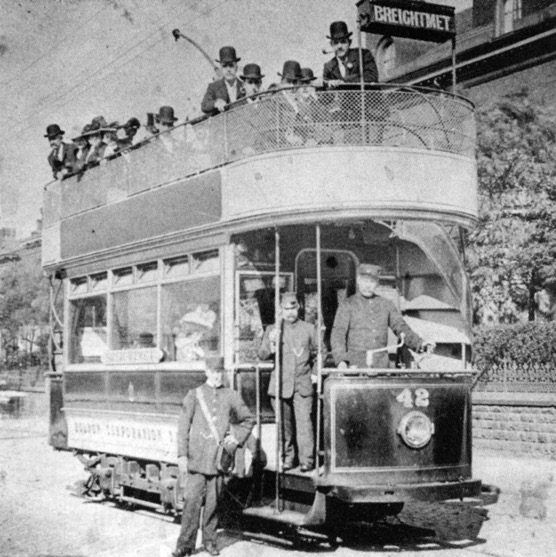
A very early photograph (1900) of Tramcar No 42, built for — and later delivered to — Stockport Corporation Tramways, but on loan to Bolton. Photo courtesy of the Tramways and Light Railway Society, with thanks to David Voice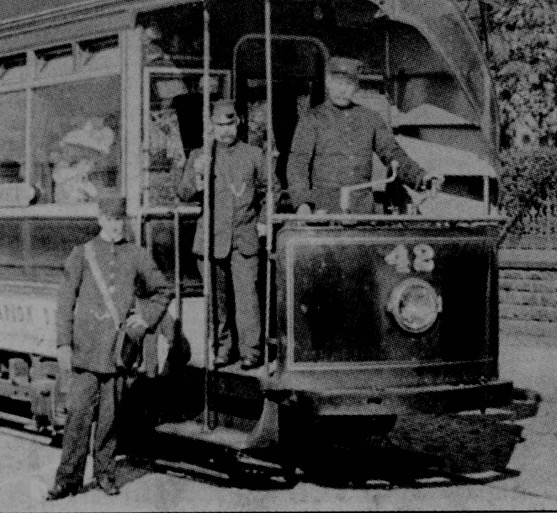
An enlargement of the above photograph showing a conductor, an inspector and the motorman, all wearing single-breasted tunics and drooping-peak caps.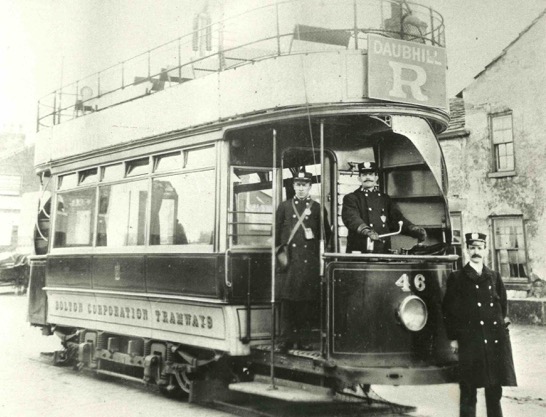
A conductor, a motorman and an inspector with Tramcar No 46 — photo undated, but probably taken in 1900 or shortly thereafter, as the tram is in open-topped condition. With thanks to Stephen Howarth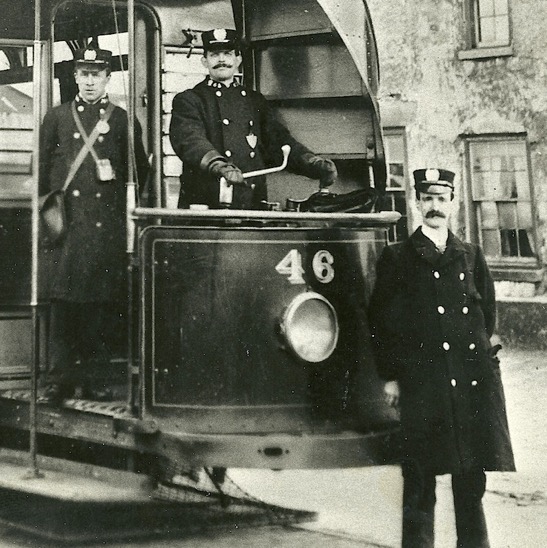
An enlargement of the above photograph showing the conductor, motorman and inspector, all of whom are wearing double-breasted greatcoats and drooping-peak caps that bear a large, elaborate cap badge. Whilst the conductor is wearing a round licence badge, his motorman's is shield shaped. With thanks to Stephen Howarth.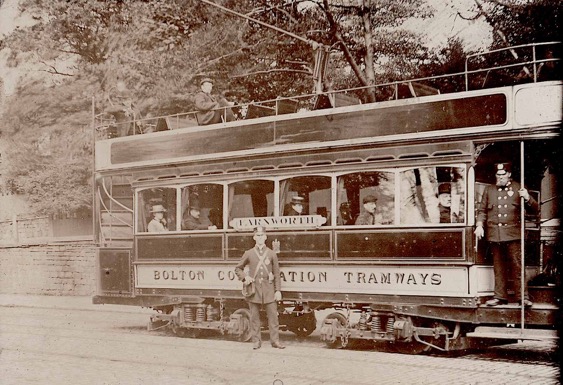
A conductor (in long, calf-length jacket) and a motorman, pose with an almost new tramcar of the 50-59 series, somewhere on the Bolton Rd to Manchester Rd section of the route to Farnworth — photo undated, but probably taken in 1901 or 1902. Photo courtesy of Ted Gray.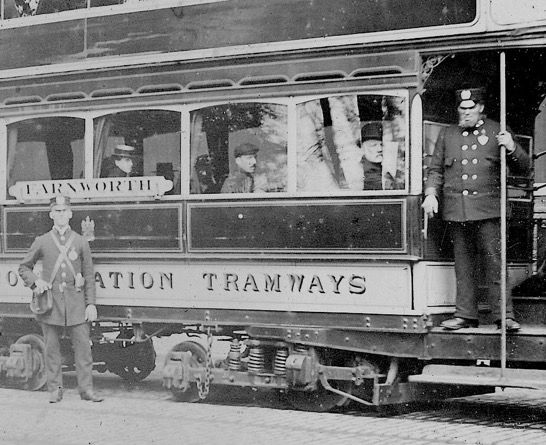
An enlargement of the above photograph showing the crew. The motorman is wearing a distinctive double-breasted jacket with very closely spaced buttons. The conductor's and motorman's licences are clearly different shapes. Photo courtesy of Ted Gray.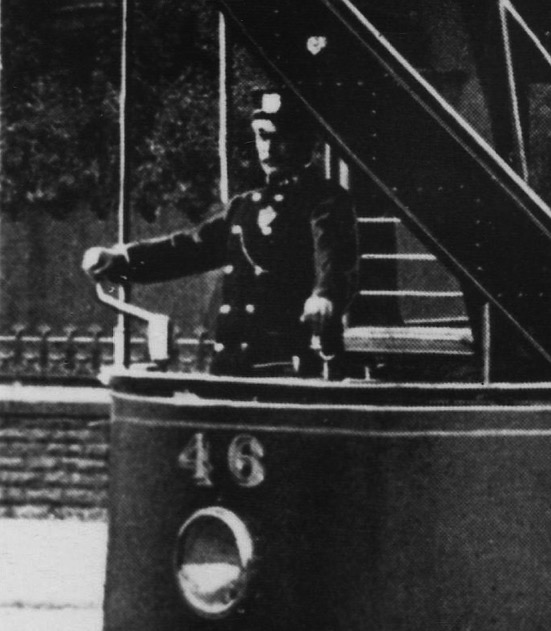
A rather poor quality but early photograph of a Bolton motorman at the controls of Tramcar No 46 — photo undated, though from the pristine condition of the tram (with top cover), probably taken in 1903 when No 46 was so fitted. The motorman is wearing a drooping-peak cap with a large cap badge, as well as a shield-shaped licence badge (on his breast). Photo courtesy of the Tramways and Light Railway Society, with thanks to David Voice.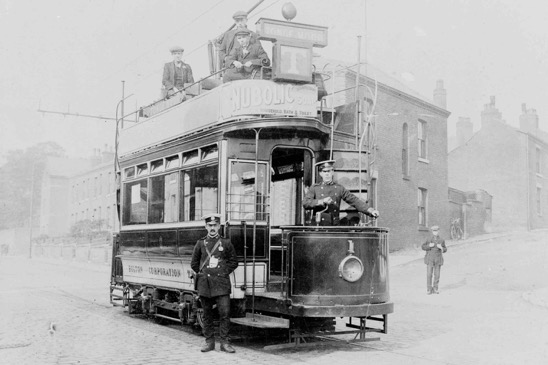
A conductor and a motorman pose with Tramcar No 1 on a service for Tonge Moor — photo undated, but probably early Edwardian. With thanks to the National Tramway Museum.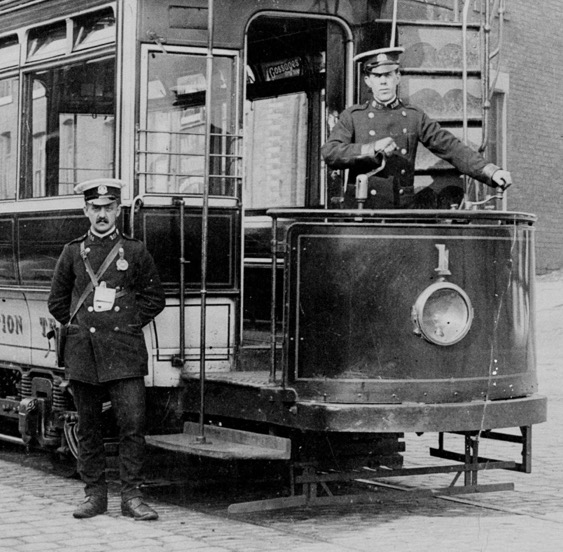
An enlargement of the above photograph showing the crew, both of whom are wearing tensioned-crown caps bearing a new pattern of cap badge (shown below). The employee numbers, worn on both the left and the right collars are easily discerned.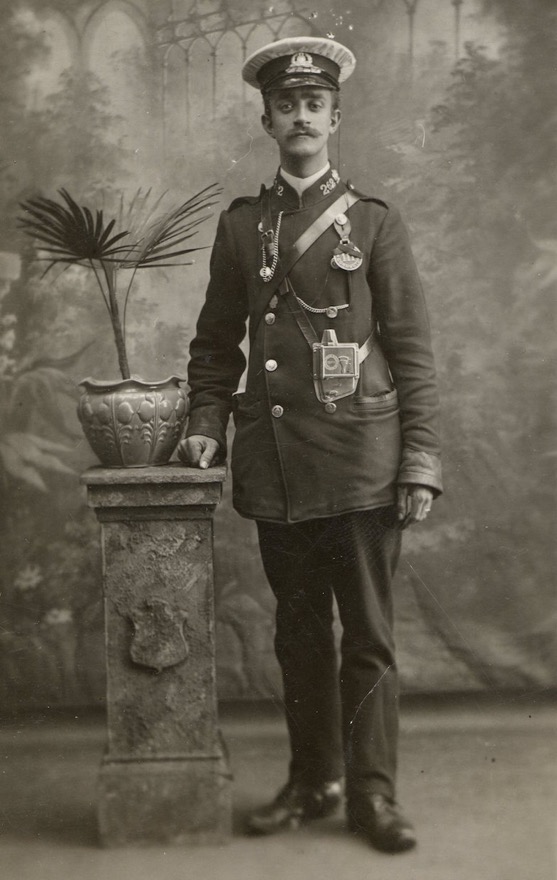
A studio portrait of a Bolton Corporation Tramways conductor (Employee No 262) — photo undated, but probably mid-to-late Edwardian. Author's Collection.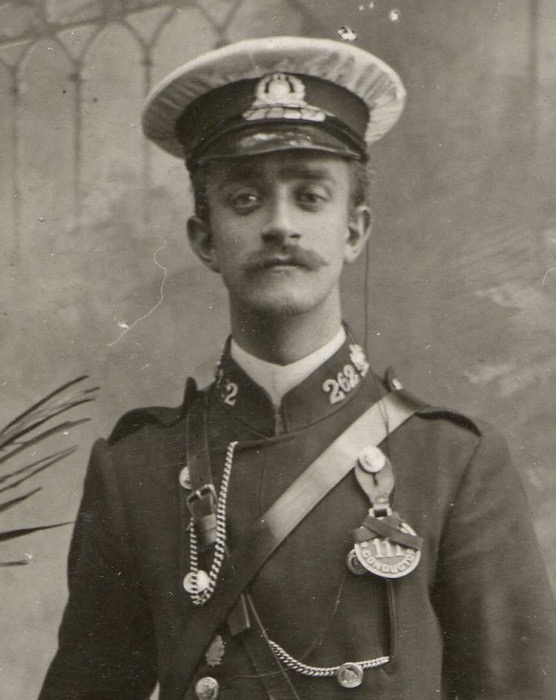
An enlargement of the above photograph showing details of the cap badge, collar insignia and the municipal licence badge (Conductor 111). The employee and licence numbering system were evidently unconnected.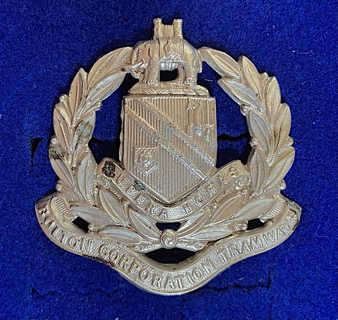
A Bolton Corporation Tramways cap badge — nickel. This pattern of cap badge, in nickel, was probably introduced around 1903, and was eventually superseded by chrome, probably in the 1930s or 1940s. Author's Collection.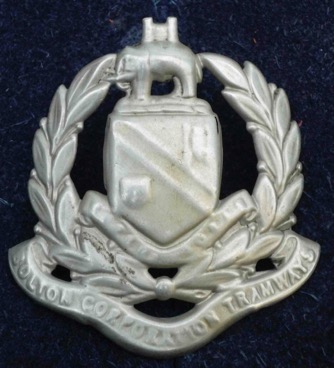
A well-worn Bolton Corporation Tramways cap badge, reputedly owned by George Jackson — nickel. Author's Collection.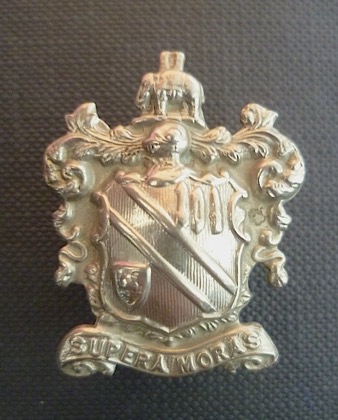
A Bolton Corporation municipal-device badge — nickel. This were worn on the jacket collars and epaulettes, and towards the end of tramway operations, occasionally on the caps instead of the larger cap badges. Author's Collection.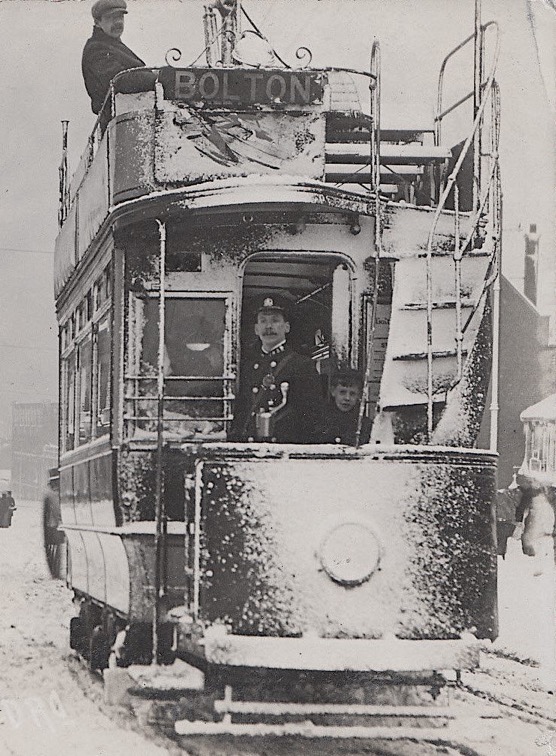
A wonderful photograph of an unidentified BCT tram (in the No 1-48 series) and its conductor on Chorley Old Road — photo undated, but believed to have been taken on the 25th January 1907. Source unknown.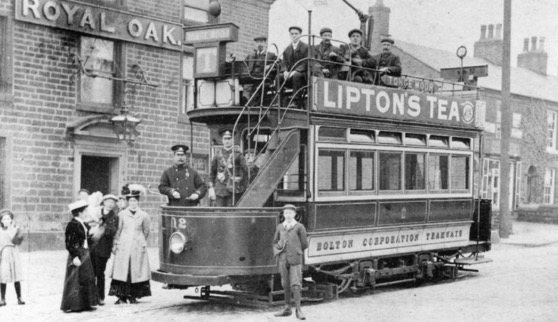
A motorman and a conductor pose aboard Tramcar No 12 at the Tonge Moor terminus (outside the Royal Oak) — photo undated, but believed to have been taken circa 1908. Photo courtesy of the Tramways and Light Railway Society, with thanks to David Voice.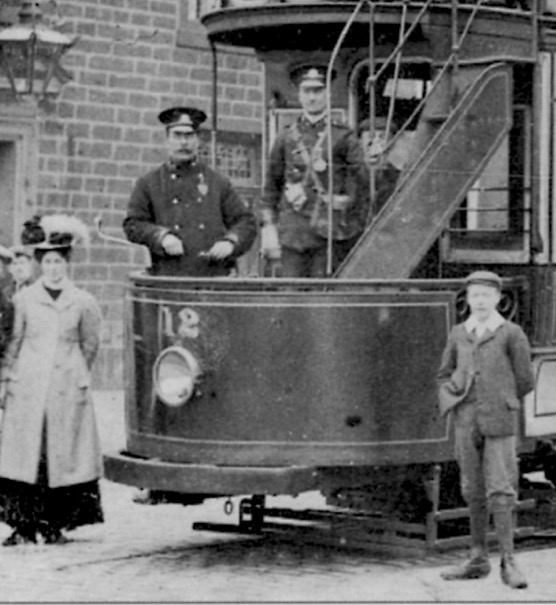
An enlargement of the above photograph showing the crew. Once again, the motorman is clearly wearing a shield-shaped licence badge, whilst his conductor has a round one. 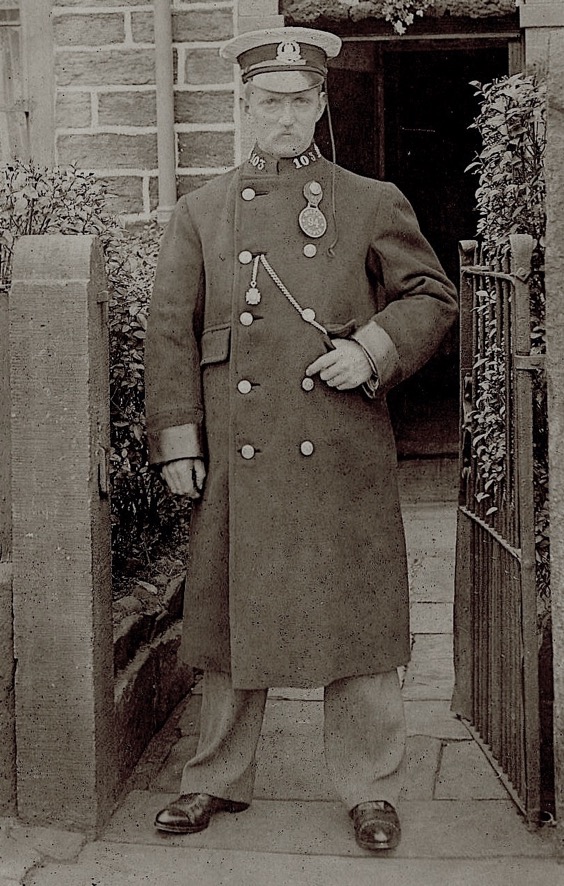
A Bolton Corporation Tramways motorman — photo undated, but probably taken prior to the Great War. The licence is round rather than shield-shaped, with 'BOLTON DRIVER 94'; his employee number is 103. Author's Collection.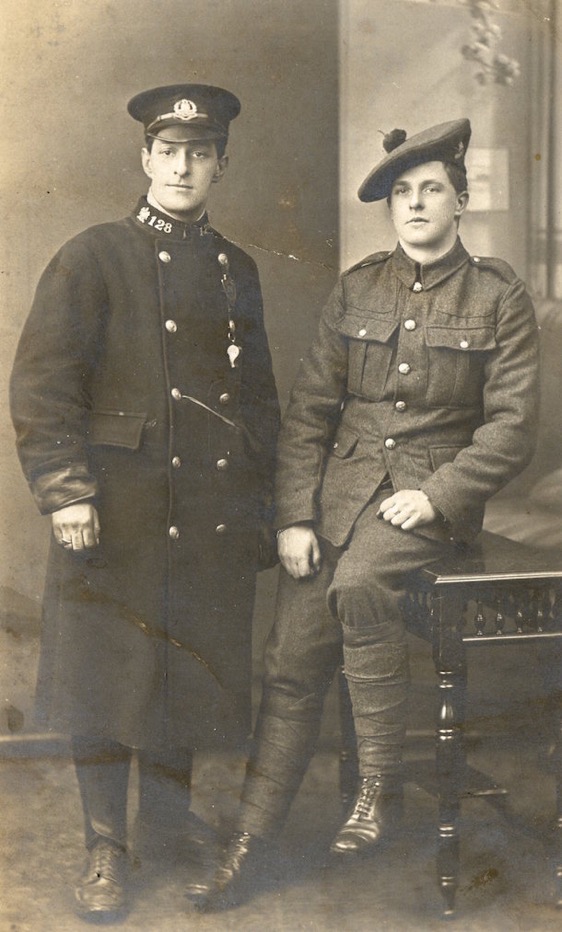
Bolton Corporation Tramways Employee No 128, along with his brother, who is wearing a Cameron Highlanders beret bearing a Machine Gun Corps cap badge — photo undated, but certainly taken during the Great War. The rear of the postcard says: "With best love & wishes from your affectionate brothers, H & P". Author's Collection.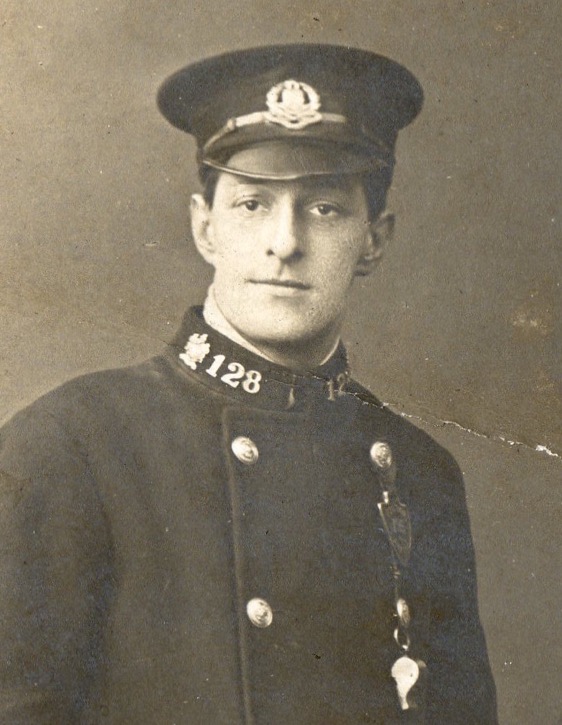
An enlargement of the above photograph showing details of the collar insignia and the cap badge. The licence badge is difficult to make out, but the length of the wording is consistent with him being a motorman.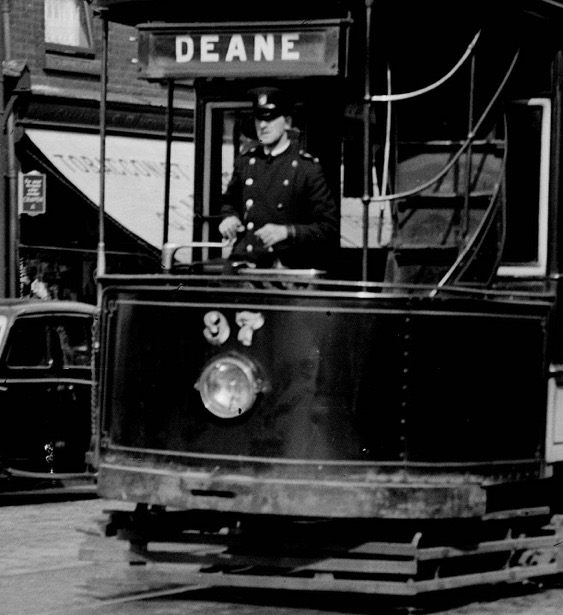
A motorman at the controls of Tramcar No 97 on a service to Deane — photo undated, but probably shortly before or shortly after the Second World War. The badge on the epaulettes is the small, municipal-device badge depicted above (in nickel) and below (in chrome). Photographer, H B Priestley. With thanks to the National Tramway Museum.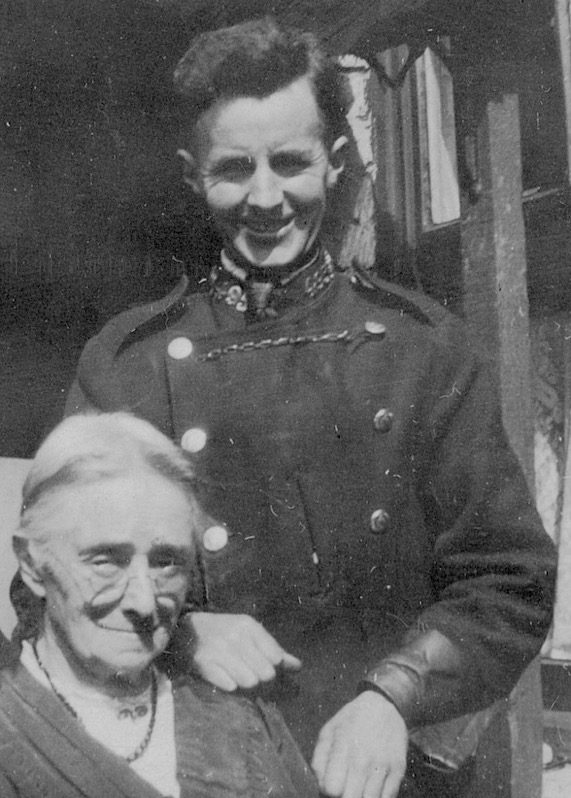
Bolton Corporation Tramways Conductor A Brindle — photo undated, but probably taken either shortly before or shortly after the Second World War. The collars of his lancer-style tunic bear his employee number ('495'), along with a small municipal-device badge, the latter worn before the number on his right-hand collar and after the number on his left-hand collar. In contrast, his jacket epaulettes are completely devoid of insignia. Author's Collection.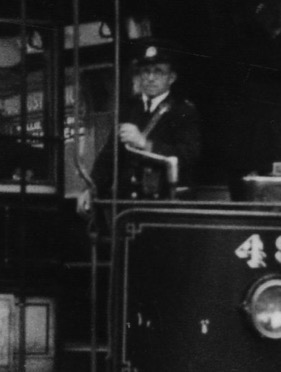
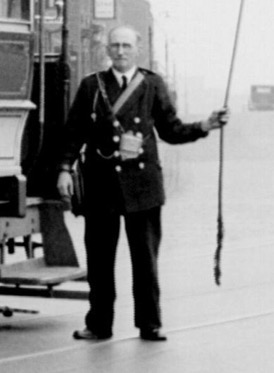
Two photographs of conductors taken in the last years of operation, showing the change to double-breasted jackets with lapels and epaulettes. Photo courtesy of the Tramways and Light Railway Society, with thanks to David Voice.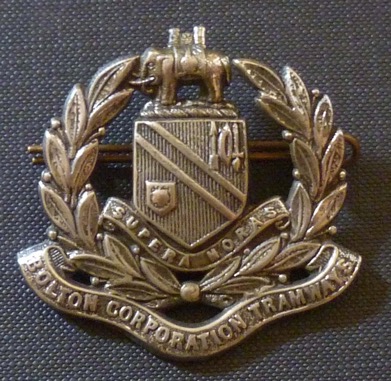
A Bolton Corporation Tramways cap badge — chrome. This material was probably used from the late 1930s or 1940s onwards. Author's Collection.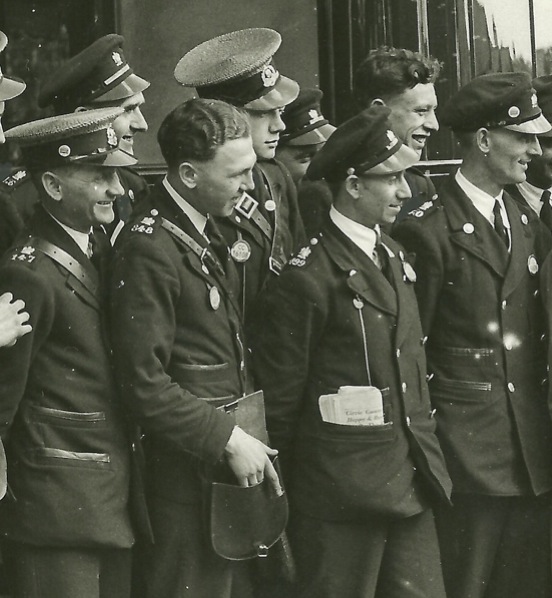
A group of bus conductors listen attentively to a group of inspectors (see photo below) on the 12th August 1938. Some conductors are wearing simple municipal-device cap badges, whereas others have the larger cap badge. All the conductors are wearing the municipal-device badge on their epaulettes, along with their respective employee numbers. With thanks to Stephen Howarth.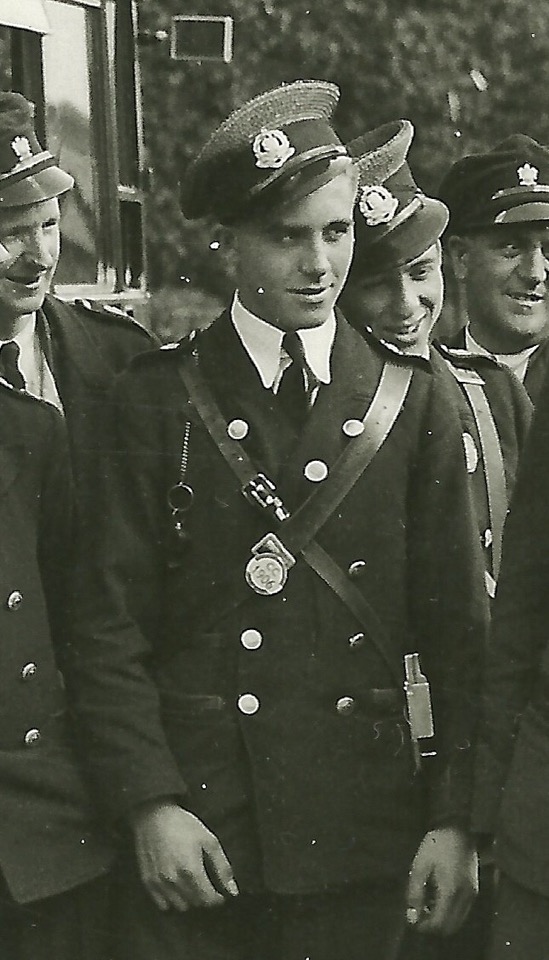
Another enlargement from the same photograph as the previous image, showing a conductor — his PSV badge is 'CC 1906'. With thanks to Stephen Howarth.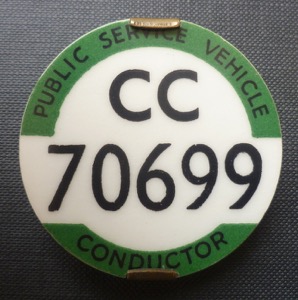
North Western Traffic Area PSV badge No 70699. Author's Collection.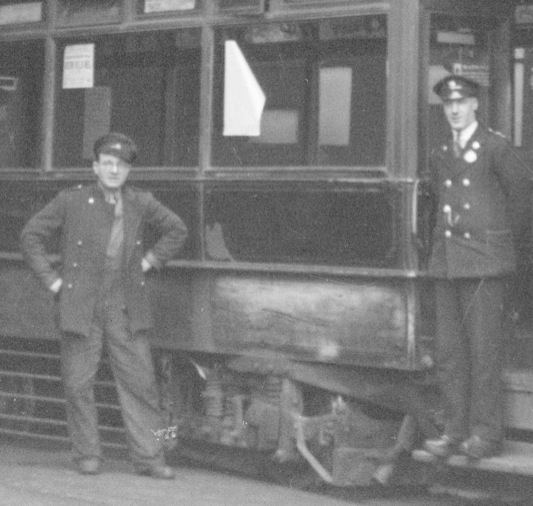
A member of the depot staff (dressed in a lancer-style tunic) and a conductor or motorman, pose at the depot with Tramcar No 404 — photo undated, but almost certainly taken shortly before closure. Photographer W G Thomas. With thanks to the National Tramway Museum.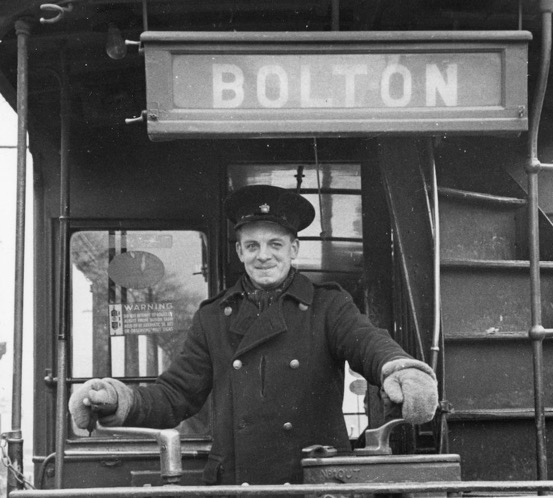
A Bolton motorman at the controls of an unidentified tramcar — photo undated, but probably taken in the 1940s. Author's Collection.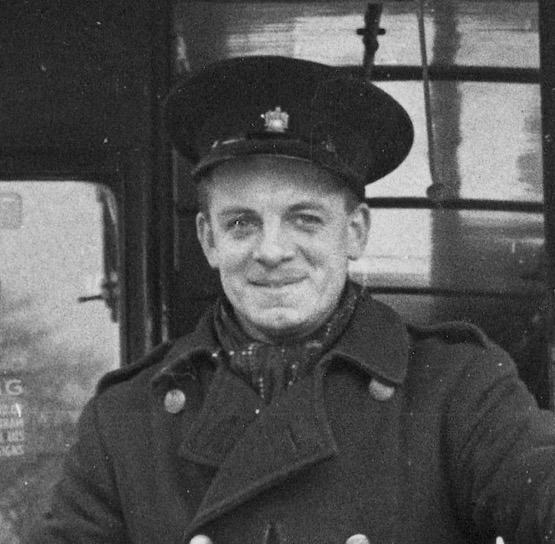
An enlargement of the above photograph, which clearly shows that the cap badge is the same small municipal shield badge that was usually worn on the collars and epaulettes.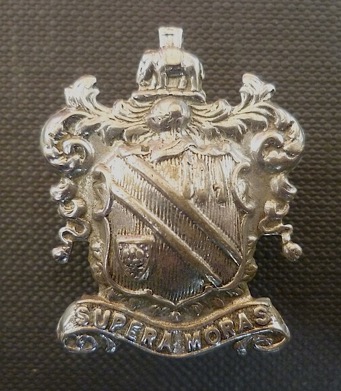
A Bolton Corporation Tramways municipal-device badge — chrome. Badges in this material were worn on the jacket epaulettes, and were probably introduced in the late 1930s or 1940s, when the use of chrome use became much more widespread. Author's Collection.
Senior staff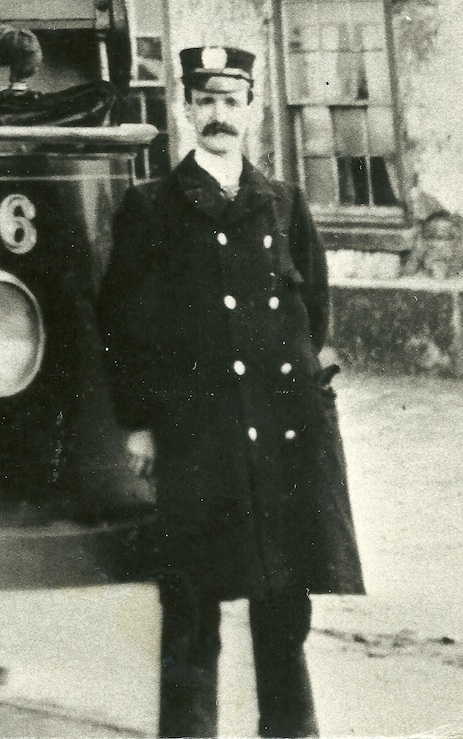
An enlargement of the shot of Tramcar No 46 above showing the inspector — probably dating to 1900. With thanks to Stephen Howarth.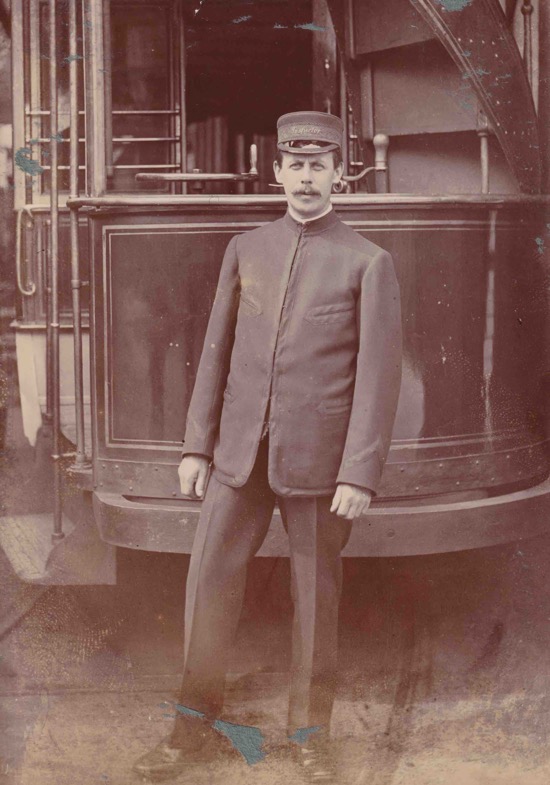
A photograph that is purportedly of a Bolton Corporation Tramways inspector — photo undated, but probably taken in the mid-Edwardian era. Author's Collection.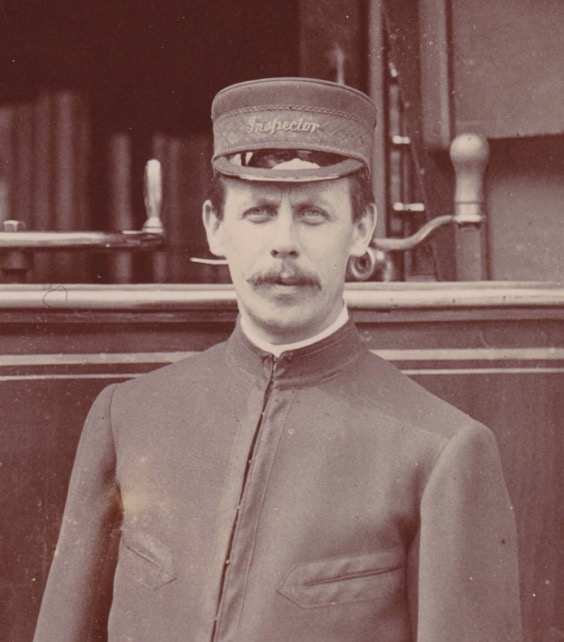
An enlargement of the above photograph showing details of the cap insignia, which is embroidered on a brocade hat band.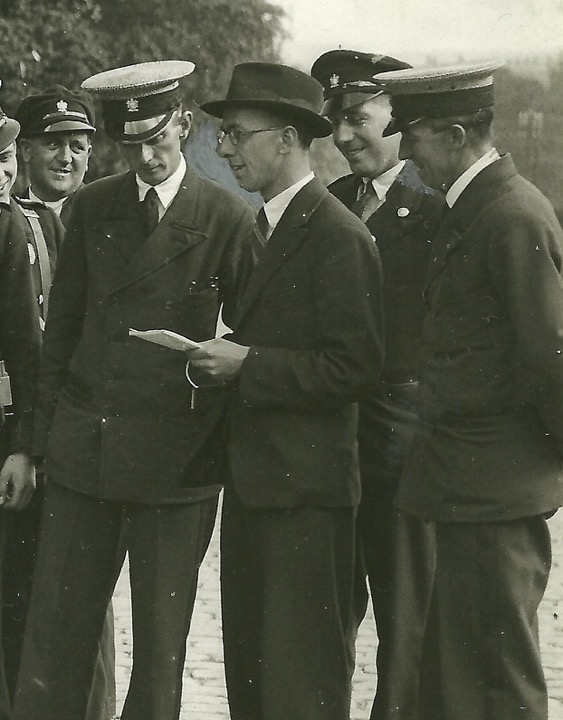
Two Bolton Corporation Transport inspectors engaged in earnest discussion with a large group of bus and tram conductors (see photograph above) on the 12th August 1938. Two of the inspectors have straw-topped caps. The simple, unmarked Bolton municipal-device badge is easily made out. With thanks to Stephen Howarth.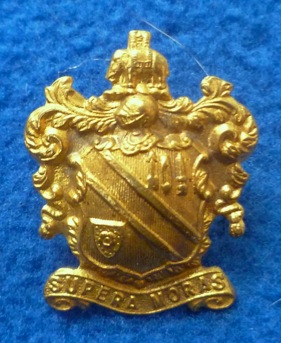
Possible Bolton Corporation Tramways inspector's cap badge — gilt. Author's Collection.
Female staff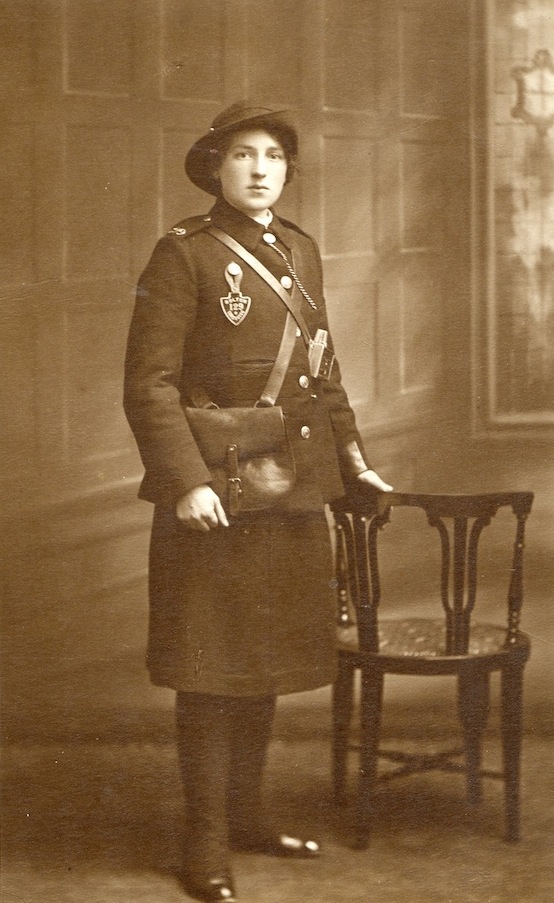
Bolton Corporation Tramways Great War conductress. Author's Collection.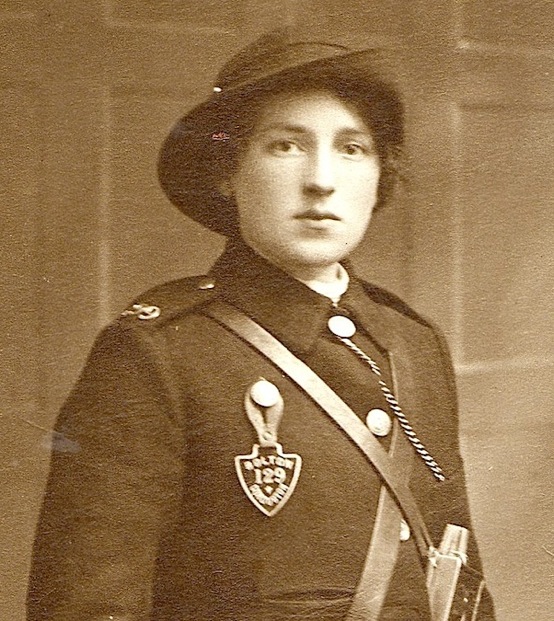
An enlargement of the above photograph, revealing the lady in question to be Employee No 99. The licence badge is 'BOLTON CONDUCTOR 129', and is shield-shaped rather than round.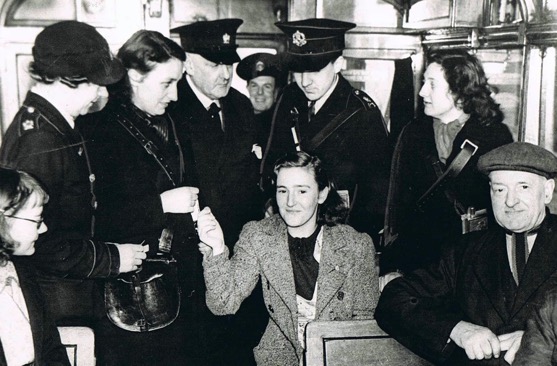
Three conductresses (only one of whom appears to be wearing a uniform) being trained under the watchful eye of an inspector and a conductor in 1941. Photo courtesy of the Bolton 66 Group, with thanks to Tony Young.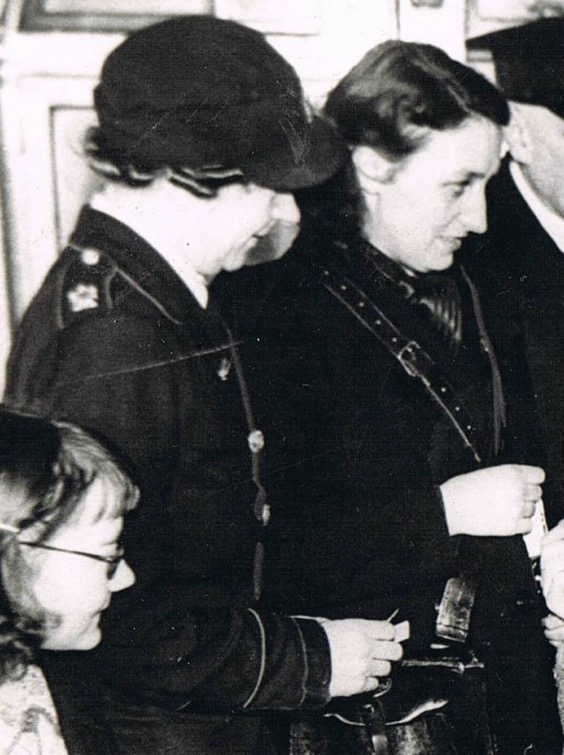
An enlargement of the above photograpph showing two of the conductresses. The lady on the left is wearing a piped, single-breasted jacket with lapels and epaulettes; her cap is not unlike a military field cap.